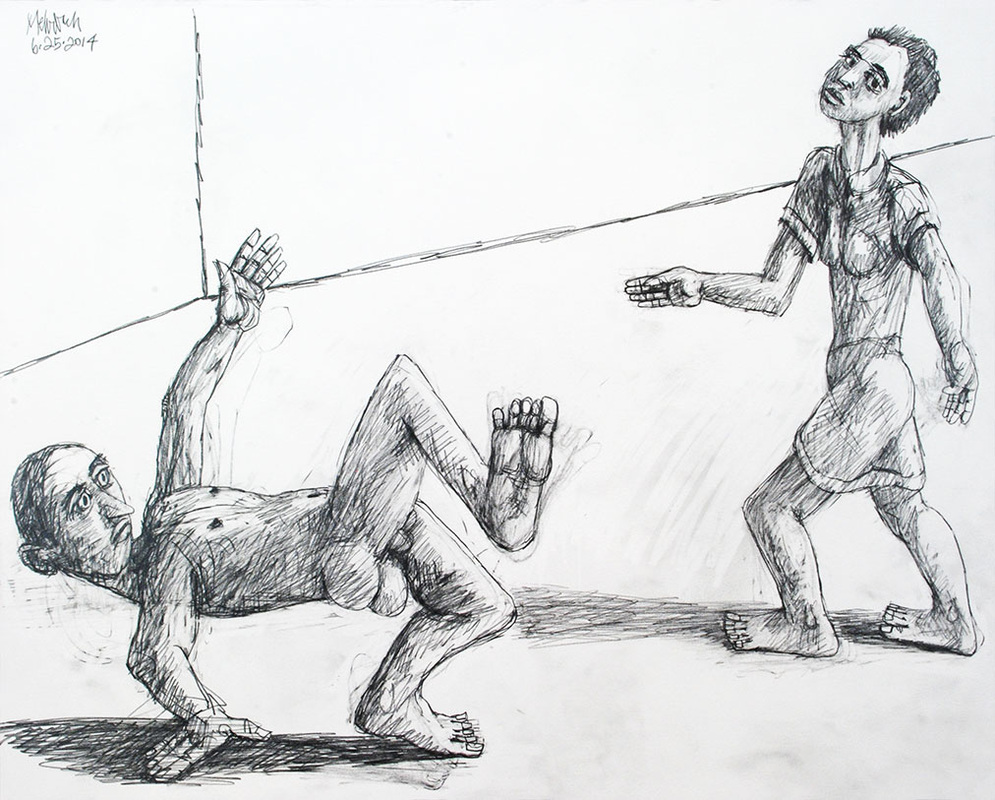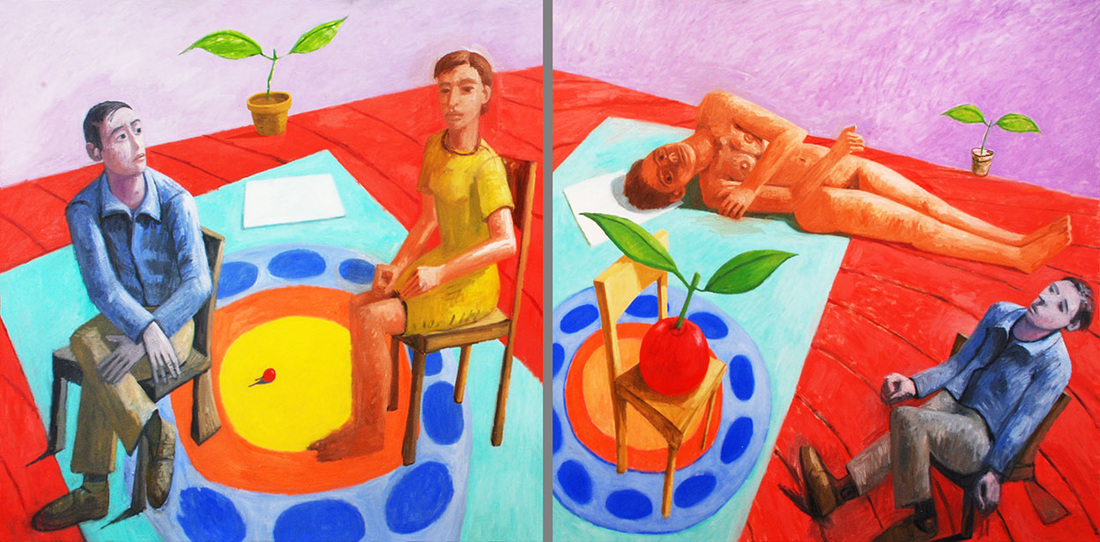|
Yesterday was a slow, sunny, warm, and enjoyable summer day. I needed to slow down, look around. That I did with these two drawings. The curve coming is the final assay, and response, to the painting Untitled Diptych-04·15·2014. I am preparing myself.
BTW: I have been playing with the means to reproducing my work for this blog and for my website, MEHRBACH.com. Today's reproduction of yesterday's drawings are far from the originals. I am trying to get better, but I lament that this blog reproduces mere semblances of the real things. There are times, like yesterday, when I don't want to make decisions, I just want to fly. The direction doesn't matter. It felt like meditation, but of course, it was not. In some ways I simply fell back into the usual pattern: the couple. Willem de Kooning had his women, I have my couples. The couples are much more than a subject, they are the meat to make the stew. They are just beginnings, but the ends are complex combinations of questions and answers. More questions, than answers.
On such days as yesterday, one purpose is to distance myself from the painting that is in process. Especially at the stage in which I find Untitled Diptych-04·15·2014. If I give in to drawing I store up a bit more intuition, and some good energy. Then, when I return to paint, I will paint with more energy, and clearer, more incisive, deliberation. The painting will finish up well, without me wasting my time. Most of the questions I posed in Untitled Diptych-04·15·2014 have been answered. To finish I require more ardent finesse than creative invention. I finally found a the head for the man on the right. Like everything else in the painting, Untitled Diptych-04·15·2014, that man's head went through a myriad of appearances until I found one I could accept as true.
Yesterday's drawing returned me to my occasional play with relative sizes. In this case, man versus woman. It is also further investigation into the space created when an object hits a wall (revisiting a similar inquiry seen in the drawing reproduced in yesterday's post). Consequently the shadow defines space between itself, the wall, and the floor. There is a third piece of research. It is the complex invention that is the woman's body. Distorted, as it is, in order to animate the spatial composition. Her crisscrossed limps and torso are severely foreshorten. Her complexity of form, and her relatively large size, are juxtaposed against the comparatively simple upright form, and small size, of the man. Why does my present work feel conservative to me? As the present painting, Untitled Diptych-04·15·2014, is nearing resolution, I can feel the next question I wish to tackle. When I review this painting in this format, reproduced here, this painting looks to me like mere preparation of things to come, places to go. I am deceiving myself. Every day, upon my first entrance into the studio, the grandness of this painting is sensorially powerful. Its size, its composition, its forms, its artifice of light and space, are engrossing and compelling. In the past, when I reached this stage of development, I moved on to the next painting. Not this time. I am wending my way through this painting, acquiring tremendous knowledge, knowledge I need to go forward to new works.
Yesterday's drawing is an experimentation with spatial play and composition. When I play this way a few discoveries intensify the process a long the way. And afterwards, I enjoy looking at the little discoveries. In this case I am writing about the man at the left, stretched out in extreme foreshortening. I particularly like his head and the way it twists off his torso, creating the triangle of space between it, the floor, and the wall. The form of the head itself is also expressively satisfying to me. Two days ago I made a series of three drawings. In each I explored a different aspect of composition. The final drawing in that series had me investigating the creation of the third-dimension on two-dimensional paper. Of the three drawings, its subject matter is the most unusual. When I focus on compositional research it appears I allow the content of the drawing to appear without self-criticism. This is probably good. In any case, as I do my research through drawing I follow instinct and intuition to where ever it takes me. Yesterday, while in a compositional exploratory mode, I produced the drawing you see here. Weird subject? I am not going to worry about it. I do enjoy its dynamic composition, generated by unusual forms and spatial play.
Every one of these drawings was done in a spirit of adventure and openness. In process, each felt right and good. All three drawings are my large size (16X20 inches). All of them are different in spatial play. Yesterday, my overall thought process was the same as always. Even when I did not paint, I am looking for solutions for my painting. In these drawings I am asking questions about detail versus overall concept. I was exploring in order to finish the painting Untitled Diptych-04·15·2014. The solutions to yesterday's drawings will help me finish my present painting, and all my work going forward.
Today I show you the work I did on 06/20/2014 — that's 3 days ago! I was away. During my travels I saw a painting by my youthful mentor, Philip Guston. It hung in the Smith College Museum of Art in Northampton, Massachusetts, a gift of Philip's wife, Musa. Guston's painting was reassuring. Its demanding overall conceptualization demonstrated a resolution similar to the one I am questioning as I move toward the completion of Untitled Diptych-04·15·2014. The question? Where in Untitled Diptych-04·15·2014 do details became important? I am beginning to believe Untitled Diptych-04·15·2014 is so much more about the overall impact of the composition than it is about individual details. I must know when to stop painting. It looks very good right now. I believe it will be done with a little bit more work on the faces, and with some clean up of the muddy areas of the surface created by painting wet over wet.
I handled the the drawing I show here easily, despite its complexity. In some ways I feel I went too far. I pulled the drawing away from its more expressive middle development to finish off the details. In the 1920's Henri Matisse said the great amount of work he had done made it look as if his paintings were made easily. In the 1930's and 1940's Matisse produced a series of paintings that he exhibited with photographs of the many states they went though to get to their final versions. You can see some of these photos, and also reproductions of the paintings they preceded, in the catalog, Matisse: In Search of True Painting, from 2012 exhibition at the Metropolitan Museum in Art in New York City. So "No!", it isn't going to get any easier. Yesterday I spent several hours on the woman's head in the left panel in the painting Untitled Diptych-04·15·2014. It is better, and nearly complete. Yes, this painting is moving forward, toward finality, but I am becoming an analytical artist in search for true painting! (The title of the Metropolitan Museum of Art's exhibition catalogue comes from something that Matisse wrote in a letter to his wife in 1919, namely that his artistic goal was always to "push further and deeper into true painting.")
Yesterday's drawing clearly represents my search for "trueness." It also took a few hours, as I made the effort to spin together form, volume, shape, depth, and composition. That's a short list of the concerns that animate my search for trueness. After my recent flirtation with Modigliani I have returned to the painting Untitled Diptych-04·15·2014 with more clarity. Yesterday I worked on the man on the left. The composition is better. Increased clarity comes because I have accepted the conflict between shape and volume. Shapes are the nails that secure this painting's composition, while the volumes create the 3-dimensional reference to visual reality. The volumes also create a secondary compositional play as the viewer moves in and out, up and down, and through the forms.
Yesterday's drawings exhibit my continuing fascination with shape versus volume versus reference to visual reality. Yes, I have upped my desire to deal with this conundrum. So, today's title refers to the consequent increased richness of my work. I am asking myself more questions. I have more problems to solve. I have accepted an increase in the level of difficulty. Wow, I'm enjoying this! This drawing was made in two isolated spurts. A couple of household problems arose, so my day was divided. Nevertheless, I am happy with this drawing because it reckoned with my recent flirtation with Modigliani and the competition in my work between shape and volume. Modigliani solved this problem in his own way, and now I am in the midst of solving it for myself. I love the artifice of volume on a two-dimensional surface. This has led me to the enjoyment of the art of people such as Amedeo Modigliani (who solved this problem in a peculiarly early 20th century manner), but also to the art of Michelangelo Merisi da Caravaggio (1571-1610) and Georges de La Tour (1593-1652).
|
To read my profile go to MEHRBACH.com.
At MEHRBACH.com you may view many of my paintings and drawings, past and present, and see details about my life and work. Archives
April 2024
|




















 RSS Feed
RSS Feed